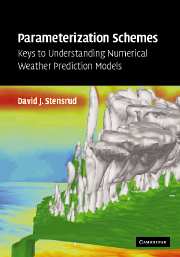Book contents
- Frontmatter
- Contents
- Preface
- List of principal symbols and abbreviations
- 1 Why study parameterization schemes?
- 2 Land surface–atmosphere parameterizations
- 3 Soil–vegetation–atmosphere parameterizations
- 4 Water–atmosphere parameterizations
- 5 Planetary boundary layer and turbulence parameterizations
- 6 Convective parameterizations
- 7 Microphysics parameterizations
- 8 Radiation parameterizations
- 9 Cloud cover and cloudy-sky radiation parameterizations
- 10 Orographic drag parameterizations
- 11 Thoughts on the future
- References
- Index
7 - Microphysics parameterizations
Published online by Cambridge University Press: 05 September 2013
- Frontmatter
- Contents
- Preface
- List of principal symbols and abbreviations
- 1 Why study parameterization schemes?
- 2 Land surface–atmosphere parameterizations
- 3 Soil–vegetation–atmosphere parameterizations
- 4 Water–atmosphere parameterizations
- 5 Planetary boundary layer and turbulence parameterizations
- 6 Convective parameterizations
- 7 Microphysics parameterizations
- 8 Radiation parameterizations
- 9 Cloud cover and cloudy-sky radiation parameterizations
- 10 Orographic drag parameterizations
- 11 Thoughts on the future
- References
- Index
Summary
Introduction
As discussed more fully in the previous chapter, moist convection plays a very important role in the atmosphere. Moist convection is a key link in the El Niño–Southern Oscillation that influences global circulation patterns, while organized mesoscale regions of convection are also known to modify the local and large-scale environments across the globe. Moist convection produces clouds, some of which can persist for days, influencing the absorption and scattering of solar radiation and the absorption of terrestrial radiation. Clouds also affect the concentration of aerosol particles through scavenging, precipitation, and chemical interactions.
Cloud formation is accomplished primarily by upward vertical air movement in cloud-free regions leading to patches of air that have relative humidities in excess of 100%. Once the relative humidity is above 100%, cloud droplets can form producing clouds. The microphysical processes that govern cloud particle formation, growth, and dissipation on very small scales play an important role in how moist convection develops and evolves. Cloud microphysical processes are very important to predictions of the atmosphere at temporal scales ranging from minutes to centuries, owing to the effects of latent heat release due to the phase changes of water and the interactions between clouds and radiation (GEWEX 1993).
Cloud microphysical processes represent an important uncertainty in climate modeling. Increases in aerosols due to either anthropogenic or natural causes produce an increase in cloud droplet concentration.
- Type
- Chapter
- Information
- Parameterization SchemesKeys to Understanding Numerical Weather Prediction Models, pp. 260 - 305Publisher: Cambridge University PressPrint publication year: 2007
- 1
- Cited by



